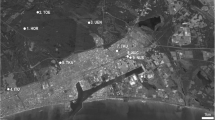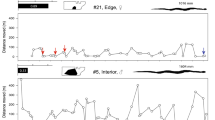Abstract
Populations of Partulina redfieldi, an achatinelline tree snail studied in four isolated trees, grew 100–900% between 1983 and 1995. Beginning in 1995, populations declined by 85%, and shells of rat-killed snails accumulated beneath the trees. While rat-marked shells were always present in the study area, numbers increased significantly. Despite a rat-abatement program begun in 1995, the snails continued to disappear, which we conclude was due to continued rat migration into the study area, despite baiting, and a switch in rat-food preference toward the snails. In neighboring forest where tree canopies are more continuous, snail density is lower and rat predation is not apparent. Captive-bred snails were successfully introduced to a small unoccupied tree in the same area in 1989, and this population suffered the same fate as the natural snail populations. Since 2000, P. redfieldi populations have remained low and rat predation continues.









Similar content being viewed by others
References
Atkinson IAE (1989) Introduced animals and extinctions. In: Western D, Pearl MC (eds) Conservation for the twenty-first century. Oxford University Press, Oxford
Atkinson IAE (2001) Introduced mammals and models for restoration. Biol Conserv 99:81–96
Begon M (1979) Investing animal abundance: capture–recapture for biologists. University Park Press, Baltimore
Blackwell GL, Potter MA, McLennan JO et al (2003) The role of predators in ship rat and house mouse population eruptions: drivers or passengers? Oikos 100:601–613
Brook FJ (2000) Prehistoric predation of the landsnail Placostylus ambagiosus Suter (Stylommatophora: Bulimulidae), and evidence for the timing of establishment of rats in northernmost New Zealand. J Roy Soc N Z 30(3):227–241
Courchamp F, Chapuis JL, Pascal M (2003) Mammal invaders on islands: impact, control and control impact. Biol Rev 78:347–383
Cowie RH, Evenhuis NL, Christensen CC (1995) Catalog of the native land and freshwater mollusks of the Hawaiian Islands. Backhuys Publishers, Leiden
Diamond J (1985) Rats as agents of extermination. Nature 318:602–603
Dowding JE, Murphy EC (1994) Ecology of ship rats (Rattus rattus) in a kauri (Agathis australis) forest in Northland, New Zealand. N Z J Ecol 18(1):19–28
Eason CT, Wickstrom M (2001) Vertebrate pesticide toxicology manual (poisons). Information on poisons used in New Zealand as vertebrate pesticides. Department of Conservation Technical Series 23. Department of Conservation, Wellington
Efford MG, Fitzgerald BM, Karl BJ et al (2006) Population dynamics of the ship rat Rattus rattus L. in the Orongorongo Valley, New Zealand. N Z J Zoo 33:273–297
Freeland WJ, Janzen DH (1974) Strategies in herbivory by mammals: the role of plant secondary compounds. Am Nat 108:269–289
Gerrish G, Mueller-Dombois D (1999) Measuring stem growth rates for determining age and cohort analysis of a tropical evergreen tree. Pac Sci 53:418–429
Gillies C et al (2006) Diphacinone bait for ground control of rats on mainland conservation land. Science for Conservation 270. Department of Conservation, Wellington, New Zealand. Available on-line at www.doc.govt.nz
Gulick JT (1905) Evolution, racial and habitudinal. Carnegie Inst., Washington
Hadfield MG (1986) Extinction in Hawaiian achatinelline snails. Malacologica 27:67–81
Hadfield MG, Miller SE (1989) Demographic studies on Hawai’i’s endangered tree snails: Partulina proxima. Pac Sci 43:1–16
Hadfield MG, Mountain BS (1980) A field study of a vanishing species, Achatinella mustelina (Gastropoda, Pulmonata), in the Waianae Mountains of Oahu. Pac Sci 34:345–357
Hadfield MG, Miller SE, Carwile AH (1993) The decimation of endemic Hawaiian tree snails by alien predators. Am Zoo 33:610–622
Hadway LJ, Hadfield MG (1999) Conservation status of tree snail species in the genus Partulina (Achatinellinae) on the island of Hawai’i: a modern and historical perspective. Pac Sci 53:1–14
Holdaway RN (1996) Arrival of rats in New Zealand. Nature 384:225–226
Holdaway RN (1999) A spatio-temporal model for the invasion of the New Zealand archipelago by the Pacific rat Rattus exulans. J Roy Soc N Z 29:91–105
Holland BS, Hadfield MG (2002) Islands within an island: phylogeography and conservation genetics of the endangered Hawaiian tree snail Achatinella mustelina. Mol Ecol 11:365–375
Holland BS, Hadfield MG (2004) Origin and diversification of the endemic Hawaiian tree snails (Achatinellidae: Achatinellinae) based on molecular evidence. Mol Phylogenet Evol 32(2):588–600
Howald G, Donlan CJ, Galvan JP et al (2007) Invasive rodent eradication on islands. Conserv Bio 21(5):1258–1268
IUCN World Conservation Union Species Survival Commission (2007) Red list of threatened species database. http://www.iucnredlist.org. Cited 12 September 2007
King CM (ed) (2000) The handbook of New Zealand mammals. Oxford University Press, New Zealand
Kirch PV (1982) The impact of the prehistoric polynesians on the Hawaiian ecosystem. Pac Sci 36:1–14
Kobayashi SR, Hadfield MG (1996) An experimental study of growth and reproduction in the Hawaiian tree snails Achatinella mustelina and Partulina redfieldi (Achatinellinae). Pac Sci 50:339–354
Loope LL, Mueller-Dombois D (1989) Characteristics of invaded islands, with special reference to Hawai’i. In: Drake J, di Castri F, Groves R, Kruger F, Mooney HA, Rejmanek R, Williamson M (eds) Biological invasions: a global perspective. Wiley, New York
Lydeard C, Cowie RH, Ponder WF et al (2004) The global decline of nonmarine mollusks. Bioscience 54:321–330
MacArthur RH, Wilson EO (1967) The theory of Island biogeography. Princeton University Press, Princeton
Major HL (2004) Impacts of introduced Norway rats (Rattus norvegicus) on least auklets (Aethia pusilla) breeding at Kiska Island, Aleutian Islands, Alaska during 2001–2003. Dissertation, Memorial University of Newfoundland
Perkins RCL (1899) Introduction. In: Sharp D (ed) Fauna Hawaiiensis. Cambridge University Press, Cambridge, pp Ixv–ccxxviii
Powell AWB (1938) The Paryphantidae of New Zealand No. IV, and the genus Placostylus in New Zealand. Rec Auckl Inst Mus 2:133–150
Proctor DL (ed) (1994) Grain storage techniques: evolution and trends in developing countries. FAO Agricultural Services Bulletin, Rome, p 109
Rasband WS (1997–2007) ImageJ, U.S. National Institutes of Health Bethesda, Maryland. http://rsb.info.nih.gov/ij/
Rufaut CG, Gibbs GW (2003) Response of a tree weta population (Hemideina crassidens) after eradication of the Polynesian rat from a New Zealand island. Restor Ecol 11:13–19
Simberloff D (2000) Extinction-proneness of island species—causes and management implications. Raffles Bull Zoo 48(1):1–9
State of Hawaii Archives (1967) Memorandum to the Board of Agriculture from State Veterinarian, 13 January 1967. Series 457: Correspondence and subject files of the chairman of the Board of Agriculture 1959–1984. Hawaii State Archives, Honolulu
State of Hawaii Archives (1968) Memorandum to the chairman of the Board of Agriculture from the deputy, 6 June, 1968. Series 457: Correspondence and subject files of the chairman of the Board of Agriculture 1959–1984. Hawaii State Archives, Honolulu
State of Hawaii Archives (1970) Report of Molokai-Maui trip, 1 October 1970. Series 457: Correspondence and subject files of the chairman of the Board of Agriculture 1959–1984. Hawaii State Archives, Honolulu
State of Hawaii Archives (1972a) Letter to Mr. Jules Dudoit and others. Subject: Tuberculosis in Cattle and Deer on Molokai, 17 August 1972. Series 457: Correspondence and subject files of the chairman of the Board of Agriculture 1959–1984. Hawaii State Archives, Honolulu
State of Hawaii Archives (1972b) Memorandum to Mr. Sunno Kido, Chairman, Department of Land and Natural Resources. Subject: Request for assistance in eradicating stray cattle—TB problem on Molokai, 31 August, 1972. Series 457: Correspondence and subject files of the chairman of the Board of Agriculture 1959–1984. Hawaii State Archives, Honolulu
Tamarin RH, Malecha SR (1971) The population biology of Hawaiian rodents: demographic patterns. Ecology 52(3):383–394
Vitousek PM, Loope LL, Stone CP (1987) Introduced species in Hawai’i: biological effects and opportunities for ecological research. Trends Ecol & Evol 2(7):224–227
Zimmerman EC (1970) Adaptive radiation in Hawai’i with special reference to insects. Biotropica 2:32–38
Acknowledgments
The authors are deeply indebted to many colleagues, present and former students, volunteers, family members and others who have participated in the field work on Moloka’i over the last 26 years. They are far too many to mention by name, but their contribution made this study possible. Major contributions were made by Dr. Stephen E. Miller, who participated in planning, field work and analyses up through the early 1990s. Barbara Shank and Anne Carwile were also important participants in the field effort for many years. Critical support for our work as well as continued access to the field site in the Kamakou Preserve was provided by The Nature Conservancy’s Moloka’i field office. We gratefully acknowledge Mr. Ed Misaki of that office for logistic support, making 4-wheel-drive vehicles available to get to the study, use of the field cabin and providing critical help when our field trips appeared to be doomed by weather or road conditions. TNC also generously provided us with their rat baiting data for use in this report. Funds to support this research have come principally from the Tree Snail Studies account at the University of Hawai’i Foundation, which relies on contributions from the senior author of this paper and many generous colleagues.
Author information
Authors and Affiliations
Corresponding author
Rights and permissions
About this article
Cite this article
Hadfield, M.G., Saufler, J.E. The demographics of destruction: isolated populations of arboreal snails and sustained predation by rats on the island of Moloka’i 1982–2006. Biol Invasions 11, 1595–1609 (2009). https://doi.org/10.1007/s10530-008-9409-9
Received:
Revised:
Accepted:
Published:
Issue Date:
DOI: https://doi.org/10.1007/s10530-008-9409-9




